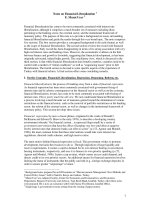Financial instruments
Bạn đang xem bản rút gọn của tài liệu. Xem và tải ngay bản đầy đủ của tài liệu tại đây (802.38 KB, 35 trang )
Financial instrument
Group 7: Van Thi
Ngoc
Tran Thi
Ly
Hoang
Thi Ngoc Mai
Outline
I.
II.
III.
IV.
Financial Instruments
Debt Instruments
Share Instruments
Comparison Between Debt
Instruments and Share
Instruments
Click icon to add picture
1. Definition: Video
are borrowing instruments held by
lenders.
I. FINANCIAL
INSTRUMEN
TS
are monetary contracts
are assets that can be traded
2. Types of Financial
Instruments
Share/Equity
Debt
Deposit
Click icon to add picture
II. DEBT
INSTRUMENT
S
1. Definition
- For the issuer: a security to raise funds
- For the holder: a fixed income asset (interest +
principal)
A contractual agreement - pay at regular
interval until the maturity date
Types
The number of year
2. The maturity
of Debt
Instruments
Long – term debt
≥ 10 years
Intermediate – term debt
Short – term debt
1 ≤ x < 10 years
< 1 year
Click icon to add picture
3. Types of Debt
instruments
II. DEBT
INSTRUMEN
TS
Bonds
Mortgages
Commercial papers
Certificate of Deposits
Bankers’ acceptances
…………….
Click icon to add picture
II. DEBT
INSTRUMENT
S
4. Bonds in Vietnam
Main types of bonds in Vietnam
- Based on issuers:
+ Government bonds
+ Local government/ municipal
bonds
+ Corporate bonds
II. Debt Instruments
4. Bonds in Vietnam
Bond investing
Types
Risk
Government bonds
low
Local government
bonds/ municipal
bonds
Corporate bonds
Liquidity
high
Interest
rate
Purpose
low
Financing the
national debt
medium medium
medium
Financing public
interest projects
high
high
Financing firm’s
funds
low
II. Debt Instruments
4. Bonds in Vietnam
Current Vietnam credit ratings, according to main rating agencies.
Website: World Government Bonds
II. Debt
Instruments
5. Vietnam Government
bonds
+ issued by the Ministry of
Finance
+ with a specified term
denomination and interest
rate.
REGULATIONS ON THE ISSUE OF GOVERNMENT
BONDS issued along with Decree of the
Government No. 72 CP on the 26th of July 1994)
II. Debt Instruments
5. Vietnam Government bonds
- are issued in the following forms:
+ Treasury credits: < 1 year.
+ Treasury bonds: ≥ 1 year
+ Project bonds: ≥ 1 year (specific projects in accordance
with the State's investment plan)
REGULATIONS ON THE ISSUE OF GOVERNMENT BONDS
issued along with Decree of the Government No. 72 CP on the 26th of July 1994
II. Debt Instruments
5. Vietnam Government bonds
- Are bought in VND
- Are repaid in VND
- The Buyer:
+ select the types of bond.
+ buy in unlimited quantities.
REGULATIONS ON THE ISSUE OF GOVERNMENT BONDS
issued along with Decree of the Government No. 72 CP on the 26th of July 1994
II. Debt Instruments
5. Vietnam Government bonds
- The Buyer:
+ Vietnamese inside/outside the country.
+ Foreigners working and living in Vietnam.
+ Vietnamese businesses in all economic sectors.
+ Associations and mass organizations.
+ Enterprises with foreign-invested capital (operating in accordance
with the Law on Foreign Investment in Vietnam and the Ordinance on
Banks if they get the approval of the Ministry of Finance.)
REGULATIONS ON THE ISSUE OF GOVERNMENT BONDS
issued along with Decree of the Government No. 72 CP on the 26th of July 1994
II. Debt Instruments
5. Vietnam Government bonds
- can be bought and sold at the stock market
- are transferrable and inheritable.
- can be used as collateral or mortgage.
- cannot be used as substitute for money in payment or as tax payments
to the State.
REGULATIONS ON THE ISSUE OF GOVERNMENT BONDS
issued along with Decree of the Government No. 72 CP on the 26th of July 1994
II. Debt Instruments
5. Vietnam
Government bonds
Yield Curve of Vietnam
Government Bonds
Website: Investing.com
II. Debt
Instruments
5. Vietnam
Government
bonds
Website: World Government Bonds
Defi nition
Dividend yield
Face value
Benefits & Risks
Market value
Dividend
Share
Instruments
Ways to reduce risks
Factors
Click icon to add picture
A smallest unit of the capital of the
company
‘Shares’ mean ownership in
a particular company
Shares represent:
Owner’s rights to the company’s
profits
Provide the authority to make
decisions concerning company’s
problems
DEFINITION
Click icon to add picture
DIVIDEND
A dividend is a payment made by a
corporation to its shareholders, usually
as a distribution of profits
Dividends are decided and managed by
the company’s board of directors
Dividends can be issued as cash
payments, as shares of stock, or other
property
Not all companies pay dividends to their
shareholders
Dividends can be paid:
Quarterly
Semi - annually
Annually
Click icon to add picture
The dividend yield of a share is
the dividend per share, divided by
the price per share
Dividend yield = Return on your
investment
% Dividend yield = x100%
Higher dividend yields aren’t always
attractive investment opportunities
DIVIDEND
YIELD
Click icon to add picture
FACE VALUE
Original value of a stock/ share stated
on the share certificate
Face value is fixed
It’s not related to the share price in
the secondary/ stock market
Equity capital = F.V x No. of shares
Dividend amount is calculated as
percentage of face value & hence
face value is kept very low
Click icon to add picture
Current trading price of stock
Market perception about future of Co.
Includes value of Intangible Assets
MARKET
VALUE
Benefits
& Risks
Ease
of trading
Volatility
Flexibility
Credit risk
Capital growth
Sector specific
risk
Low
costs
Lack of knowledge
Liquidity
Unexpected events
Available
information
Ways to
reduce
risks
Diversify portfolio
Have a long-term
outlook
Research investments before
making them
Monitor investments regularly
and reallocate resources as
necessary
Factors that
infuence
share prices
Supply and Demand
Economic factors (interest rate, economic outlook,
deflation, inflation,..etc)
Company’s earnings









